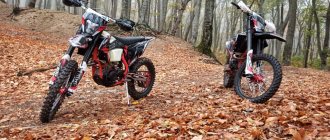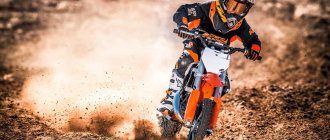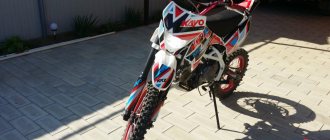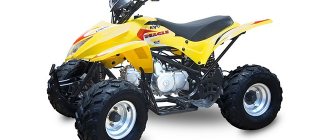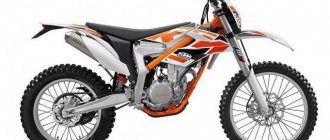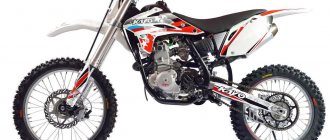Kayo 125 is one of the best-selling pit bikes on the domestic motor market, as well as the closest competitor to the Irbis TTR 125 model.
Light motocross motorcycles or pit bikes are gradually gaining popularity in our country. This is mainly due to Chinese manufacturers. In terms of price/quality ratio, Chinese models fully meet the expectations of their “riders”; this is confirmed by the Kayo series of motorcycles.
The Chinese company Kayo has been producing pit bikes since 1999. Having gained popularity and respect at home, the company entered the international market and is increasing production volumes every day. Currently, Kayo produces more than 30,000 motorcycles a year, and the model line includes more than 25 different modifications, designed not only for riding on regular roads, but also for participating in competitions.
Kayo 125 Basic and Classic
The simplest configuration of a 125 cc bike is called Basic. The more advanced version of the Classic differs from the basic one in the presence of a headlight, a battery, and a modified front fork.
The CRF801-7L Classic model can be found with a 120 cc engine. see (Lifan), or with a more powerful 140 cc. see (YX 140cc). Another important difference is the tire sizes. The classic version is equipped with two types of wheels: 14/12 or 17/14 inches.
The Kayo model line has other modifications (Mini-A, Motard, Super Moto, Pro), but since our site is dedicated to 125cc motorcycles, we will tell you in more detail about the classic Kayo 125cc version.
The bike is equipped with a relatively high-speed 125 cc (120 cc) air-cooled engine. There are practically no complaints about his work. To facilitate the passage of air, there is a zero-resistance filter at the inlet. The gearbox is mechanical and has 4 speeds. The gear shift order is non-standard (the first position is neutral, the remaining gears are up). Of the numerous reviews from owners, it is worth noting the slightly tight operation of the gearbox, as well as the elusive neutral.
The steel frame has a birdcage shape and is painted black. At the front there is an inverted telescopic fork with golden-colored stays. At the rear there is a regular pendulum with a monoshock absorber (hardness adjustment is possible). Front and rear disc brakes are single-piston. Direct-flow type muffler. The gas tank is plastic and has a separate pressure relief valve. The wings and facings are made of soft plastic, which bends quite easily, but does not break.
There is no instrument panel, but there is an hour meter and an electronic tachometer.
Review of Kayo pit bikes
Kayo 125 WildCat, Kayo 140 CraZyCat, Kayo 150 VorteXCat - three wild CATS!
Pit bikes, which have become incredibly widespread abroad, are for some reason considered an “unseen animal” in the vastness of our homeland. This technique is a smaller copy of a cross bike, which is equally convenient for both children and adults. The scope of application of pit bikes is extremely diverse: motocross, stunt riding, supermoto and enduro. Well, let's meet three representatives of this class. My first acquaintance with this technique took place via the Internet. Looking at the nice photographs of this “miracle”, I still had little idea of the dimensions of the pit bike, and even more so, its behavior under the yoke of the 85-kilogram “carcass” of the tester. However, interest was born even then. I was able to test three models of the same brand at once: Kayo 125 WildCat , Kayo 140 CraZyCat and Kayo 150 VorteXCat . As the names suggest, they have engines of 125, 140 and 150 cubic centimeters, respectively. Actually, this is their main difference, because the chassis of pit bikes is almost the same. They are based on a spatial tubular steel frame with a very decent quality of welds and a competent design (probably copied from European pit bikes). The front suspension is an adjustable (!) upside-down fork, and at the rear there is a cast aluminum swingarm, which is supported by a monoshock absorber. The latter, by the way, has an adjusting washer for adjusting the preload of the spring.
In addition, pit bikes come standard with brake, clutch and gearbox levers that fold when dropped, which significantly extends their service life in conditions of frequent falls. “Pleasant little things” also include thick white vinyl stickers on the plastic, which are located in places where there is likely to be contact with the “underlying surface,” silicone steering wheel grips and a valve cap on the gas tank cover, which prevents gasoline from leaking out during falls. I decided to start with the younger, 125 cc model. Contrary to my fears, the pit bike started from the very first push of the kickstarter. Wow, the sound is clearly not relative to the engine size. Not constrained by legislative standards for noise and exhaust toxicity, the Chinese bolted a direct-flow exhaust system onto the pit bike! That’s why this “octagon” sounds no worse than a cross-country 450 (adjusted for decibels).
Sitting behind the wheel, I felt quite at ease. The ergonomics of the driver's seat are clearly designed for an adult, as is clearly demonstrated by the seat height, which is 835 mm! I squeeze the clutch, press the gearshift foot... and stand still. It turned out that the gears on these pit bikes are switched according to the N-1-2-3-4 (instead of the usual 1-N-2-3-4). I would not call such a technical solution successful. Just imagine: you approach a corner of a cross-country track at good speed, shift down gears, but miss the first gear, ending up in neutral. As a result, instead of sharp acceleration after the apex and a fountain of earth from under the rear wheel, the pit bike only “idles” scares the area with a loud roar. In addition, “catching neutral” in a static position on the Kayo 125 is an activity for puzzle lovers. Well, that’s why it’s the cheapest in the series. So, having more or less figured out the checkpoint, I started. The first gear seemed too short to me, but on reflection, I decided that this was still a plus. With such a gear ratio, even a motor that is not related to Hercules can develop decent traction. For example, in order to drag an 85-kilogram pilot up a long steep slope.
Having escaped into the “operational space,” I unscrewed the gas handle and, clicking through the gears, began to accelerate. Two-valve four-stroke engine that produces 8.3 hp. at 7500 rpm , it demonstrates good torque at low and medium speeds, but is “specifically blunt” at the “top”. Therefore, I didn’t want to experiment with maximum speed (and even on icy primers). Despite its small size, the pit bike accelerates quite quickly, but you can guess for yourself what the consequences of falling off-road, and even at a speed of about 50-60 km/h, are. The pendant left a pleasant impression. Frankly, at first I thought that it served a purely decorative function here, but the front fork and rear monoshock absorber turned out to be fully functional! Their energy intensity is enough to withstand impressive jumps or rush along the “washboard” without slowing down at the “cruising” speed of 50-60 km/h. And for off-road use this is a lot. In any case, much more than 120 on asphalt. However, it was not without its drawbacks. In contrast to the well-functioning front fork (adjusted for the oil thickening due to cold weather), the rear suspension works “so-so”, as a result of which the pilot sometimes does not understand what is happening with the rear wheel. But the hydraulic brakes do not cause any complaints. For a 71-kilogram device with a “maximum speed” of 80 km/h, their efficiency is enough “for the eyes.” However, if you put a set of light-alloy road wheels on a pit bike and put them on slicks, then even in this case the performance of the standard braking system of the newly-minted minimotard will be more than enough. Leaving the 125 to cool down to the sound of the clicking air vent, I switched to the 140 cc model. This pit bike has a slightly different frame design, different forms of plastic lining and a creative white and green coloring. By the way, the plastic on all three models turned out to be “correct”. It is soft and very flexible, that is, it does not break when dropped. CraZyCat is 20 mm shorter and the same 20 mm lower than its brothers, but this difference remains only on paper. Looking ahead, I will say that while driving I did not notice any differences between them in ergonomics and handling. Kayo 140 engine is another clone of the Honda Super Cub . This power unit produces almost 10 hp. at 8000 rpm, and is therefore equipped with an oil cooler. Despite my remaining doubts, the engine also started on the first “kick”, filling the surrounding area with a deep roar. Having clicked the gearshift foot in a static state, I was surprised to find that all gears were switched clearly, and neutral was caught “on time”. Thanks to the short first gear, careless handling of the throttle can result in the Kayo 140 CraZyCat getting into a wheelie, or even throwing off the slob pilot. Well, let's take it into account.
Due to the faster engine and clear gearbox, this pit bike is perfect for all sorts of reckless activities. As I circled around the area, I dreamed of going to an indoor BMX park. It was there, on trampolines of various configurations, that one could have a real blast. The 140 cc power unit works, how shall I put it... more expressively than the “125”. It follows the throttle better and has more impressive traction throughout the entire rev range. Having ridden the Kayo 140 , I switched to the 150 cc VorteXCat , which, with the exception of the engine, is a copy of the 125 cc WildCat. But when designing the motor, the designers did not limit themselves to simply increasing the working volume. They also increased the compression ratio, thanks to which the engine began to produce 13.6 hp. at 9500 rpm , and 11.2 Nm at 7500 rpm . And if you also remember that the dry weight of the pit bike remained at 71 kg, then you can guess that the Kayo 150 will “make” the same Yamaha YBR-125 and other road motorcycles of similar cubic capacity from the start. As expected, the engine started easily. This pit bike has an even sharper exhaust “voice” than its “younger” brothers. Well, let's see how he is in business. I engage first gear, release the clutch and... gas, gas! The pit bike rushed forward, throwing out a fountain of melted snow and dead grass from under the rear wheel. Kayo 150 motor is even more playful and spins up faster. Perhaps this device comes closest to KTM minicross motorcycles and Polini pit bikes . The positive impression of the engine is enhanced by a clearly operating gearbox with a well-catched neutral. Due to the higher degree of compression, the power unit has lost a little in elasticity compared to the 140 cc model, but at the “top” it shows a more evil disposition.
The controllability of all three fully deserves the epithet “bicycle-like” - Kayo is able to turn around on a spot with a diameter of just over a meter, and literally the power of thought is enough to change the trajectory. When I put the pit bike into a power drift to the delight of the photographer, I felt unprecedented confidence. Thanks to its low weight and low seat height, a pit bike will forgive many piloting mistakes, and maybe even teach you something. Apparently, it’s not for nothing that “bourgeois” motorcycle schools begin teaching the art of stunt riding with just such a technique. I believe that if pit bikes could be adapted for use on public roads, they would become a bestseller among active, uncomplicated youth. Having a low cost, light weight, a peppy engine and excellent handling, such devices would be an excellent alternative to other urban transport. However, even under the current situation, such devices are an excellent means for active recreation and amateur motorsports.
Completing the test drive, I was finally able to unequivocally answer the traditional question: “would you like to see such equipment in your garage?” So as I write this, the white and green Kayo 140 CraZyCat is preparing to take pride of place in the pit next to my KTM 990 Adventure.
Magazine "Motodrive" No. 1-2 (81-82)
Technical specifications Kayo 125 Classic
- type - light cross-country motorcycle (pit bike).
- country of origin - China.
- year of manufacture 2013.
- engine - 1 cylinder, four-stroke (Lifan).
- model - CRF801-7L Classic 17/14 125cc.
- maximum power - 11 hp at 8000 rpm.
- engine capacity - 120 cubic meters. cm.
- 4-speed manual transmission (N-1-2-3-4).
- fuel system - carburetor.
- ignition type - electronic CDI
- cooling system – air.
- drive - chain.
- front and rear disc brakes with reinforced hoses.
- The starting system is kickstarter only.
- wheelbase – 1225 mm.
- seat height - 885 mm.
- length - 1750 mm.
- width - 750 mm.
- height - 1130 mm.
- ground clearance - 350 mm.
- Front tire size: 70/100-17.
- Rear tire size: 90/100-14.
- dry weight – 71 kg.
- gas tank volume – 5.5 liters.
- Fuel consumption is about 2-2.5 liters. per 100 km (calm driving mode).
- maximum speed - 80 km/h.
The post is not only about running in the new pit, but also contains a little background on how I came to this run-in. The main text is about the first 5 m/h of the new Kayo 125 KRZ pit. Further along the cut. I first got on a motorcycle when I was 19 years old, as soon as I opened Cat.A. and drove the entire student body in the good old Izh Yu5. For those years and times, it was a super motorcycle, and there were no others at that time. But this is not about him. Then there was a long break and auto experience, after 10 years I bought a scooter, first 50 cc, then 150 cc, and two years ago I got on a scooter that I had wanted for a long time and still like (Steed VLS). My son is growing up and I started choosing motorcycles for him. That’s how I came across pit bikes. I read the Internet, YouTube and realized that I wanted one for myself to use both during the season and in the off-season. The choice was made on Kayo with 17/14 wheels. The choice was based on the following criteria: 1. I don’t need an adult enduro/cross bike with big wheels 2. My height and weight feel more comfortable on Pit’s 17/14 wheels (saddle height 885 mm), although I’m not standing on it at full strength either foot 3. For me to ride along forest roads without pretensions to sporting achievements, a 125 cc engine is enough, which will quite adequately drive me along paths and fields. 4. I wanted new equipment so as not to touch the traces of use of the previous owner 5. Of all the Chinese brands, Kayo had the least number of problems. 6. The price tag should be no more than 50 tr, which I was willing to spend on getting some light fun in my free time. Having put all these thoughts into one pile, I received a completely conscious decision in the form of a pit bike voiced at the beginning. This is the bike I received and started running it in.
The main text is about the first 5 m/h of the new Kayo 125 KRZ pit. Further along the cut. I first got on a motorcycle when I was 19 years old, as soon as I opened Cat.A. and drove the entire student body in the good old Izh Yu5. For those years and times, it was a super motorcycle, and there were no others at that time. But this is not about him. Then there was a long break and auto experience, after 10 years I bought a scooter, first 50 cc, then 150 cc, and two years ago I got on a scooter that I had wanted for a long time and still like (Steed VLS). My son is growing up and I started choosing motorcycles for him. That’s how I came across pit bikes. I read the Internet, YouTube and realized that I wanted one for myself to use both during the season and in the off-season. The choice was made on Kayo with 17/14 wheels. The choice was based on the following criteria: 1. I don’t need an adult enduro/cross bike with big wheels 2. My height and weight feel more comfortable on Pit’s 17/14 wheels (saddle height 885 mm), although I’m not standing on it at full strength either foot 3. For me to ride along forest roads without pretensions to sporting achievements, a 125 cc engine is enough, which will quite adequately drive me along paths and fields. 4. I wanted new equipment so as not to touch the traces of use of the previous owner 5. Of all the Chinese brands, Kayo had the least number of problems. 6. The price tag should be no more than 50 tr, which I was willing to spend on getting some light fun in my free time. Having put all these thoughts into one pile, I received a completely conscious decision in the form of a pit bike voiced at the beginning. This is the bike I received and started running it in.
First of all, I changed the shipping oil to semi-synthetic liquid moth, soaked the air vent, checked all visible bolts and... Let's go 
The first impressions were strange and ambiguous. After the weight, weight distribution, landing and engine of the main motor (Steed), the first impressions of this bike were like “oh well, how can you ride it, something is wrong, etc.” It is tall, it chatters, you have to catch it, sharp clutch, short and powerful first gear. But 5 minutes and I began to get used to it. To begin with, I drove along the roads of the nearest dachas. Then I turned onto the nearest path into the forest. Here!!! This is where his path is. Initially, I planned short rides along the country lane. Wrong. It’s not fun to drive on country asphalt, gravel and dirt roads with small bumps and holes, despite the toothed wheels and relatively soft suspension. Because driving in first is boring and dreary, and if you accelerate at least in second (15-20 km/h), then driving over small bumps turns the ride into a dull shake. Perhaps the problem is in the relatively small wheels, or maybe in something else. And only after driving out into the forest onto a road/path with more protracted potholes and bumps, the suspension began to work its magic. and where its moves were not enough, I stood on the steps and passed almost any forest irregularities without slowing down the gas. Conclusion: driving along a broken country road with dried mud at speeds below “more speed less holes” is not his element. Driving along forest paths, ruts, soft ground, deep holes - this is where it is wonderful.
I especially like its dimensions and weight. Even having driven to a place where you can no longer go or walk, since there are deep ruts on the sides with knee-deep water, and in front there is a swamp where the wheels fall through, the issue is very easily resolved. We take the bike by the tail and turn it 180 degrees in place and ride back to harder ground 
I have currently traveled 4.7 hours according to his own computer data. According to the manual, the first oil change is scheduled for 5 o'clock. As a result of these 4-plus hours, I noticed that I was looking forward to continuing the run-in, which I do between daily home/family/work.
Before the last ride, I decided to adjust the chain tension, as I noticed that when I changed the gas mode (rolling at idle/go), I could hear the clicking of the chain on the sprockets. I looked at the sag tolerance in the manual (20-24 mm), found a measurement mark on the pendulum - it turned out to be normal (apparently it was slightly overtightened from the factory). Taking advantage of the moment, I lubricated the chain. As a result, I did the last ride with a clicking sound, but the rustling of the chain (buzzing) on the tensioner (the cover on top of the pendulum) became less audible.
At the moment, nothing has fallen off, nothing has been unscrewed (except for the nut on top of the traverse, which was not tightened) and a large number of positive emotions have been received. And here is such a satisfied face 
Kayo Motorcycles
The Chinese company KAYO began its work in 1999. The first equipment that came off the company's assembly line was a children's off-road bike. This product has been adapted for the Italian user. At the moment, the company produces not only bicycles, but also motorcycles, such as ATVs, scooters, mopeds, and pit bikes.
The company actively competes with European manufacturers and supplies its equipment not only in Europe, but also in the USA. It boasts excellent quality, easy handling, simple operational properties and inexpensive repairs. KAYO manufactures motorcycles for a wide range of uses: from sports to recreation and leisure. Every year production increases, and today the company produces more than thirty thousand equipment per year.
It is noteworthy that the company values all its employees, and the president of the company personally monitors all technological production processes. KAYO has reached the global level thanks to pit bikes. Their quality, reliability and ease of control won the hearts of not only professional athletes, but also beginners.
Pit bikes are popular among young people in Europe, Asia and America. The Chinese company KAYO did not ignore the profitable technology and released the first mini-motorcycle in 1999. Now the model range offers its consumers 25 different types of motorcycles. The main direction of pit bike production is sports competitions. This technique is ideal for motocross and off-road riding. Professional athletes purchase a lightweight KAYO pit bike for practicing tricks and for training. In China, almost all cross-country racing participants use mini-motorcycles from this company. The price category depends on the purpose of the pit bike.
For example, for hobbyists, equipment is available at lower prices. KAYO pit bikes are not intended for driving on city roads, so their registration with the traffic police is not provided. The exception is four models: T2 ENDURO, T4 ENDURO, T5 SUPERMOTO, T6 ENDURO. Documents for the right to drive a vehicle are not required for a pit bike. The presented KAYO models differ from each other in engine volume and power, cooling system, design and headlights. Combines a series of Chinese motorcycles with gearbox, brake system, clutch, suspension and frame design.
